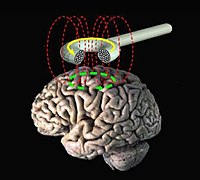
Photo from wikipedia
Given pharmacological interventions’ limited efficacy and abundance of its adverse effects, the repetitive transcranial magnetic stimulation (rTMS) is considered a viable non-invasive option for managing chronic neuropathic pain of different… Click to show full abstract
Given pharmacological interventions’ limited efficacy and abundance of its adverse effects, the repetitive transcranial magnetic stimulation (rTMS) is considered a viable non-invasive option for managing chronic neuropathic pain of different origins with promising outcomes. The provision of a systematic review of current literature on rTMS for managing chronic neuropathic pain of different origins, and assess its efficacy and outcomes, highlighting the need for standard protocols for utilizing rTMS. Variable stimulation modalities were trialed targeting the M1, DLPFC, and somatosensory cortices S1 and S2. The M1 yielded the best results in 11 of the studies. Frequency of stimulation was variable; however, optimal outcome was with higher frequencies ranging 10–20 Hz rather than low-frequency 1 Hz. Repetitive TMS can produce significant relief from chronic neuropathic pain. The lack of standard methods for rTMS, stimulatory parameters, and target stimulation site precludes concluding the optimal modality for stimulation. The practical algorithm by Lefaucheur and Nguyen (Neurophysiol Clin. 49(4):301–7, 2019) can guide setting standardized algorithms for rTMS. Defining optimal stimulation sites, frequencies, and pulses to maximize patient’s pain relief and minimize required rTMS sessions requires further research.
Journal Title: Current Pain and Headache Reports
Year Published: 2021
Link to full text (if available)
Share on Social Media: Sign Up to like & get
recommendations!